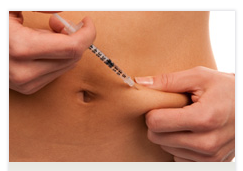The following are excerpts from Insulin Administration of Diabetes Education Online:
Injection
Insulin syringe:
This is the most common insulin delivery method. The classic injection device is an insulin syringe. The plastic, disposable syringes currently are available in three sizes, and hold up to 30, 50 or 100 units of insulin. The needles are fine (up to 31 gauge) with lengths ranging from 3/16th of an inch for infants, to ½ inch or more for adults. The insulin is injected into the layer of fat (subcutaneous tissue) just under the skin.
Insulin Pen:
A popular alternative to the insulin syringe is an insulin pen. An insulin pen has a replaceable reservoir of insulin called a cartridge, a replaceable needle to puncture the skin and to deliver insulin to the subcutaneous tissue, a dial to choose the insulin dose, and a mechanical pumping or insulin release mechanism. These may be disposable devices or re-useable devices with disposable insulin cartridges. They are very convenient for active individuals taking multiple injections, as well as those who are visually or dexterity-challenged.
Continuous Subcutaneous Insulin Infusion Device:
Continuous subcutaneous insulin infusion (CSII) devices (also known as insulin pumps) are the most sophisticated form of insulin delivery. These are small, computerized devices that are programmed to deliver insulin under the skin. The insulin pump is durable and lasts for years, but the insulin supply and certain pump components (insulin reservoir, tubing and infusion set) are changed every few days. We have provided more detailed information in the insulin pump section.
Infusion
Human regular insulin may be injected directly into the vein in a hospital setting under close medical supervision only. Insulin is added to intravenous fluids, and the insulin dose and blood sugar are strictly monitored. The intravenous route of delivery is ONLY given under a doctor’s orders in a hospital to facilitate the management of diabetes during surgery or an intensive care stay.





